Local Stiffness Assessment of Geogrid-Stabilized Unbound Aggregates in a Large-Scale Testbed
Abstract
:1. Introduction
2. Materials
2.1. Unbound Aggregates
2.2. Geogrids
3. Experimental Setup
3.1. UI–FastCell Triaxial Test Setup with Elastic Wave Transducers
3.2. Large-Scale Testbed Equipped with BE Field Sensors
4. Test Procedures
4.1. Repeated Load Triaxial Testing
4.2. Large-Scale Testbed Experiments
4.3. Dynamic Cone Penetration (DCP) and Light-Weight Deflectometer (LWD) Testing
5. Results and Discussion
5.1. Estimation of Poisson’s Ratio, Applied Bulk Stress, and Small-Strain Elastic Modulus
5.2. Vertical Stiffness Profile
5.3. DCP Testing
5.4. LWD Testing
6. Conclusions
Author Contributions
Funding
Institutional Review Board Statement
Informed Consent Statement
Data Availability Statement
Acknowledgments
Conflicts of Interest
References
- Giroud, J.P. An Assessment of the Use of Geogrids in Unpaved Roads and Unpaved Areas. In Proceedings of the Jubilee Symposium on Polymer Geogrid Reinforcement, London, UK, 8 September 2009. [Google Scholar]
- Giroud, J.P.; Han, J.; Tutumluer, E.; Dobie, M.J.D. The Use of Geosynthetics in Roads. Geosynth. Int. 2022, 30, 47–80. [Google Scholar] [CrossRef]
- Rowe, R.K.; Li, A.L. Geosynthetic-Reinforced Embankments over Soft Foundations. Geosynth. Int. 2005, 12, 50–85. [Google Scholar] [CrossRef]
- Zornberg, J.G.; Sitar, N.; Mitchell, J.K. Performance of Geosynthetic Reinforced Slopes at Failure. J. Geotech. Geoenviron. Eng. 1998, 124, 670–683. [Google Scholar] [CrossRef]
- van Eekelen, S.J.M.; Han, J. Geosynthetic-Reinforced Pile-Supported Embankments: State of the Art. Geosynth. Int. 2020, 27, 112–141. [Google Scholar] [CrossRef]
- Barker, W.R. Open-Graded Bases for Airfield Pavements; U.S. Army Corps of Engineers, Waterways Experiment Station: Vicksburg, MI, USA, 1987. [Google Scholar]
- Webster, S.L. Geogrid Reinforced Base Courses for Flexible Pavements for Light Aircraft: Test Section Construction, Behavior under Traffic, Laboratory Tests, and Design Criteria; U.S. Army Engineer Waterways Experiment Station: Vicksburg, MI, USA, 1992. [Google Scholar]
- Tingle, J.S.; Jersey, S.R. Full-Scale Evaluation of Geosynthetic-Reinforced Aggregate Roads. Transp. Res. Rec. 2009, 2116, 96–107. [Google Scholar] [CrossRef]
- Chen, Q.; Hanandeh, S.; Abu-Farsakh, M.; Mohammad, L. Performance Evaluation of Full-Scale Geosynthetic Reinforced Flexible Pavement. Geosynth. Int. 2018, 25, 26–36. [Google Scholar] [CrossRef]
- Norwood, G.J. Cyclic Plate Testing for Reinforced Airport Pavements—Phase I: Geogrid; U.S. Army Engineer Research and Development Center: Vicksburg, MI, USA, 2019. [Google Scholar]
- Cuelho, E.V.; Perkins, S.W. Geosynthetic Subgrade Stabilization—Field Testing and Design Method Calibration. Transp. Geotech. 2017, 10, 22–34. [Google Scholar] [CrossRef]
- Kwon, J.; Tutumluer, E. Geogrid Base Reinforcement with Aggregate Interlock and Modeling of Associated Stiffness Enhancement in Mechanistic Pavement Analysis. Transp. Res. Rec. 2009, 2116, 85–95. [Google Scholar] [CrossRef]
- Sugimoto, M.; Alagiyawanna, A.M.N. Pullout Behavior of Geogrid by Test and Numerical Analysis. J. Geotech. Geoenviron. Eng. 2003, 129, 361–371. [Google Scholar] [CrossRef]
- Moraci, N.; Recalcati, P. Factors Affecting the Pullout Behaviour of Extruded Geogrids Embedded in a Compacted Granular Soil. Geotext. Geomembr. 2006, 24, 220–242. [Google Scholar] [CrossRef]
- Peng, X.; Zornberg, J.G. Evaluation of Load Transfer in Geogrids for Base Stabilization Using Transparent Soil. Procedia Eng. 2017, 189, 307–314. [Google Scholar] [CrossRef]
- Teixeira, S.H.C.; Bueno, B.S.; Zornberg, J.G. Pullout Resistance of Individual Longitudinal and Transverse Geogrid Ribs. J. Geotech. Geoenviron. Eng. 2007, 133, 37–50. [Google Scholar] [CrossRef]
- Wilson-Fahmy, R.F.; Koerner, R.M.; Sansone, L.J. Experimental Behavior of Polymeric Geogrids in Pullout. J. Geotech. Eng. 1994, 120, 661–677. [Google Scholar] [CrossRef]
- Roodi, G.H.; Zornberg, J.G. Stiffness of Soil-Geosynthetic Composite under Small Displacements. II: Experimental Evaluation. J. Geotech. Geoenviron. Eng. 2017, 143, 04017076. [Google Scholar] [CrossRef]
- Zornberg, J.G.; Roodi, G.H.; Gupta, R. Stiffness of Soil–Geosynthetic Composite under Small Displacements: I. Model Development. J. Geotech. Geoenviron. Eng. 2017, 143, 04017075. [Google Scholar] [CrossRef]
- Kinney, T.C.; Stone, D.; Schuler, J. Using Geogrids for Base Reinforcement as Measured by Falling Weight Deflectometer in Full-Scale Laboratory Study. Transp. Res. Rec. 1998, 1611, 70–77. [Google Scholar] [CrossRef]
- Tang, X.; Stoffels, S.M.; Palomino, A.M. Resilient and Permanent Deformation Characteristics of Unbound Pavement Layers Modified by Geogrids. Transp. Res. Rec. 2013, 2369, 3–10. [Google Scholar] [CrossRef]
- Konietzky, H.; te Kamp, L.; Groeger, T.; Jenner, C. Use of DEM to Model the Interlocking Effect of Geogrids under Static and Cyclic Loading. In Numerical Modeling in Micromechanics via Particle Methods; Taylor & Francis Group: Abingdon, UK, 2004; pp. 3–12. [Google Scholar]
- McDowell, G.R.; Harireche, O.; Konietzky, H.; Brown, S.F.; Thom, N.H. Discrete Element Modelling of Geogrid-Reinforced Aggregates. Proc. Inst. Civ. Eng. Geotech. Eng. 2006, 159, 35–48. [Google Scholar] [CrossRef]
- Zhou, J.; Chen, J.-F.; Xue, J.-F.; Wang, J.-Q. Micro-Mechanism of the Interaction between Sand and Geogrid Transverse Ribs. Geosynth. Int. 2012, 19, 426–437. [Google Scholar] [CrossRef]
- Chen, C.; McDowell, G.R.; Thom, N.H. Investigating Geogrid-Reinforced Ballast: Experimental Pull-out Tests and Discrete Element Modelling. Soils Found. 2014, 54, 1–11. [Google Scholar] [CrossRef]
- Perkins, S.W.; Christopher, B.R.; Cuelho, E.L.; Eiksund, G.R.; Schwartz, C.S.; Svanø, G. A Mechanistic–Empirical Model for Base-Reinforced Flexible Pavements. Int. J. Pavement Eng. 2009, 10, 101–114. [Google Scholar] [CrossRef]
- Lee, J.-S.; Santamarina, J.C. Bender Elements: Performance and Signal Interpretation. J. Geotech. Geoenviron. Eng. 2005, 131, 1063–1070. [Google Scholar] [CrossRef]
- Byun, Y.-H.; Tutumluer, E.; Feng, B.; Kim, J.H.; Wayne, M.H. Horizontal Stiffness Evaluation of Geogrid-Stabilized Aggregate Using Shear Wave Transducers. Geotext. Geomembr. 2019, 47, 177–186. [Google Scholar] [CrossRef]
- Kang, M.; Kim, J.H.; Qamhia, I.I.A.; Tutumluer, E.; Wayne, M.H. Geogrid Stabilization of Unbound Aggregates Evaluated Through Bender Element Shear Wave Measurement in Repeated Load Triaxial Testing. Transp. Res. Rec. 2020, 2674, 113–125. [Google Scholar] [CrossRef]
- Kang, M.; Qamhia, I.I.A.; Tutumluer, E.; Hong, W.-T.; Tingle, J.S. Bender Element Field Sensor for the Measurement of Pavement Base and Subbase Stiffness Characteristics. Transp. Res. Rec. 2021, 2675, 394–407. [Google Scholar] [CrossRef]
- Kang, M.; Qamhia, I.I.A.; Tutumluer, E.; Garg, N.; Villafane, W. Airport Pavement Stiffness Monitoring and Assessment of Mechanical Stabilization Using Bender Element Field Sensor. Transp. Res. Rec. 2022, 2676, 542–553. [Google Scholar] [CrossRef]
- ASTM D2487-17; Standard Practice for Classification of Soils for Engineering Purposes (Unified Soil Classification System). ASTM: West Conshohocken, PA, USA, 2020.
- M145-91-UL; Standard Specification for Classification of Soils and Soil-Aggregate Mixtures for Highway Construction Purposes. AASHTO: Washington, DC, USA, 1995.
- ASTM C136-06; Standard Test Method for Sieve Analysis of Fine and Coarse Aggregates. ASTM: West Conshohocken, PA, USA, 2020.
- Illinois Department of Transportation. Standard Specifications for Road and Bridge Construction; Authority of the State of Illinois: Chicago, IL, USA, 2022. [Google Scholar]
- ASTM D1557-12(2021); Standard Test Methods for Laboratory Compaction Characteristics of Soil Using Modified Effort. ASTM: West Conshohocken, PA, USA,, 2021.
- Jewell, R.A.; Milligan, G.; Sarsby, R.W.; Dubois, D. Interaction between Soil and Geogrids. Polymer Grid Reinforcement: Proceedings of a Conference Sponsored by the Science and Engineering Research Council and Netlon Ltd. and Held in London 22–23 March 1984; The National Academies of Sciences, Engineering, and Medicine: Washington, DC, USA, 1985; ISBN 978-0-7277-0242-5. [Google Scholar]
- Tutumluer, E.; Seyhan, U. Laboratory Determination of Anisotropic Aggregate Resilient Moduli Using an Innovative Test Device. Transp. Res. Rec. 1999, 1687, 13–21. [Google Scholar] [CrossRef]
- Clayton, C.R.I. Stiffness at Small Strain: Research and Practice. Géotechnique 2011, 61, 5–37. [Google Scholar] [CrossRef]
- Jovičić, V.; Coop, M.R.; Simić, M. Objective Criteria for Determining Gmax from Bender Element Tests. Géotechnique 1996, 46, 357–362. [Google Scholar] [CrossRef]
- Viggiani, G.; Atkinson, J.H. Interpretation of Bender Element Tests. Géotechnique 1995, 45, 149–154. [Google Scholar] [CrossRef]
- Zou, Y.; Leo, C.J.; Small, J.C. Behaviour of EPS Geofoam as Flexible Pavement Subgrade Material in Model Tests. Geosynth. Int. 2000, 7, 1–22. [Google Scholar] [CrossRef]
- Siabil, S.M.A.G.; Tafreshi, S.N.M.; Dawson, A.R. Response of Pavement Foundations Incorporating Both Geocells and Expanded Polystyrene (EPS) Geofoam. Geotext. Geomembr. 2020, 48, 1–23. [Google Scholar] [CrossRef]
- Yoder, E.J.; Witczak, M.W. Principles of Pavement Design, 2nd ed.; Wiley: Hoboken, NJ, USA, 1991; ISBN 978-0-471-97780-3. [Google Scholar]
- AASHTO T 307-99; Standard Method of Test for Determining the Resilient Modulus of Soils and Aggregate Materials. AASHTO: Washington, DC, USA, 1999.
- Hula, A.; Maguire, A.; Bunker, A.; Rojeck, T.; Harrison, S. The 2020 EPA Automotive Trends Report: Greenhouse Gas Emissions, Fuel Economy, and Technology Since 1975; U.S. Environmental Protection Agency’s (EPA): Washington, DC, USA, 2021; p. 119. [Google Scholar]
- Hick, R.G.; Monismith, C.L. Factors Influencing the Resilient Response of Granular Materials. Highw. Res. Rec. 1971, 345, 15–31. [Google Scholar]
- Santamarina, J.C. Soils and Waves: [Particulate Materials Behavior, Characterization and Process Monitoring]; J. Wiley & Sons: Chichester, UK, 2001; ISBN 978-0-471-49058-6. [Google Scholar]
- Yokota, K.; Konno, M. Dynamic Poisson’s Ratio of Soil. In Proceedings of the Seventh World Conference on Earthquake Engineering, Istanbul, Turkey, 8–13 September 1980; Volume 3. [Google Scholar]
- Ohsaki, Y.; Iwasaki, R. On Dynamic Shear Moduli and Poisson’s Ratios of Soil Deposits. Soils Found. 1973, 13, 61–73. [Google Scholar] [CrossRef]
- Payan, M.; Senetakis, K.; Khoshghalb, A.; Khalili, N. Effect of Gradation and Particle Shape on Small-Strain Young’s Modulus and Poisson’s Ratio of Sands. Int. J. Geomech. 2017, 17, 04016120. [Google Scholar] [CrossRef]
- Payan, M.; Khoshini, M.; Jamshidi Chenari, R. Elastic Dynamic Young’s Modulus and Poisson’s Ratio of Sand–Silt Mixtures. J. Mater. Civ. Eng. 2020, 32, 04019314. [Google Scholar] [CrossRef]
- He, H.; Senetakis, K. A Study of Wave Velocities and Poisson Ratio of Recycled Concrete Aggregate. Soils Found. 2016, 56, 593–607. [Google Scholar] [CrossRef]
- Thompson, M.R.; Smith, K.L. Repeated Triaxial Characterization of Granular Bases. Transp. Res. Rec. 1990, 1278, 7–17. [Google Scholar]
- Brown, S.F.; Kwan, J.; Thom, N.H. Identifying the Key Parameters That Influence Geogrid Reinforcement of Railway Ballast. Geotext. Geomembr. 2007, 25, 326–335. [Google Scholar] [CrossRef]
- Mulabdic, M.; Minažek, K.; Kaluđer, J. Geogrids—What Is Important. In Proceedings of the International Conference on Road and Rail Infrastructure CETRA, Zadar, Croatia, 17–19 May 2018; p. 221. [Google Scholar]
- Holtz, R.D.; Christopher, B.R.; Berg, R.R. Geosynthetic Design and Construction Guidelines. Participant Notebook. NHI Course No. 13213 (Revised April 1998); National Highway Institute: McLean, VA, USA, 1998; p. 460. [Google Scholar]
- Tavakoli Mehrjardi, G.; Khazaei, M. Scale Effect on the Behaviour of Geogrid-Reinforced Soil under Repeated Loads. Geotext. Geomembr. 2017, 45, 603–615. [Google Scholar] [CrossRef]
- Kang, M.; Wang, H.; Qamhia, I.I.A.; Erol, T.; Wayne, M.H. Local Stiffness Enhancement by Multi-Axial Geogrid Stabilization Evaluated through Shear Wave Measurement. In Proceedings of the Geosynthetics Conference 2023, Kansas City, MO, USA, 5–8 February 2023; pp. 336–347. [Google Scholar]
- Xiao, Y.; Tutumluer, E.; Qian, Y.; Siekmeier, J.A. Gradation Effects Influencing Mechanical Properties of Aggregate Base–Granular Subbase Materials in Minnesota. Transp. Res. Rec. 2012, 2267, 14–26. [Google Scholar] [CrossRef]
- U.S. Army Corps of Engineers. UFC (Unified Facilities Criteria) Airfield Pavement Design; US Dept. of Defense: Washington, DC, USA, 2001. [Google Scholar]
- Mooney, M.A.; Miller, P.K. Analysis of Lightweight Deflectometer Test Based on In Situ Stress and Strain Response. J. Geotech. Geoenviron. Eng. 2009, 135, 199–208. [Google Scholar] [CrossRef]
- Senseney, C.T.; Mooney, M.A. Characterization of Two-Layer Soil System Using a Lightweight Deflectometer with Radial Sensors. Transp. Res. Rec. 2010, 2186, 21–28. [Google Scholar] [CrossRef]
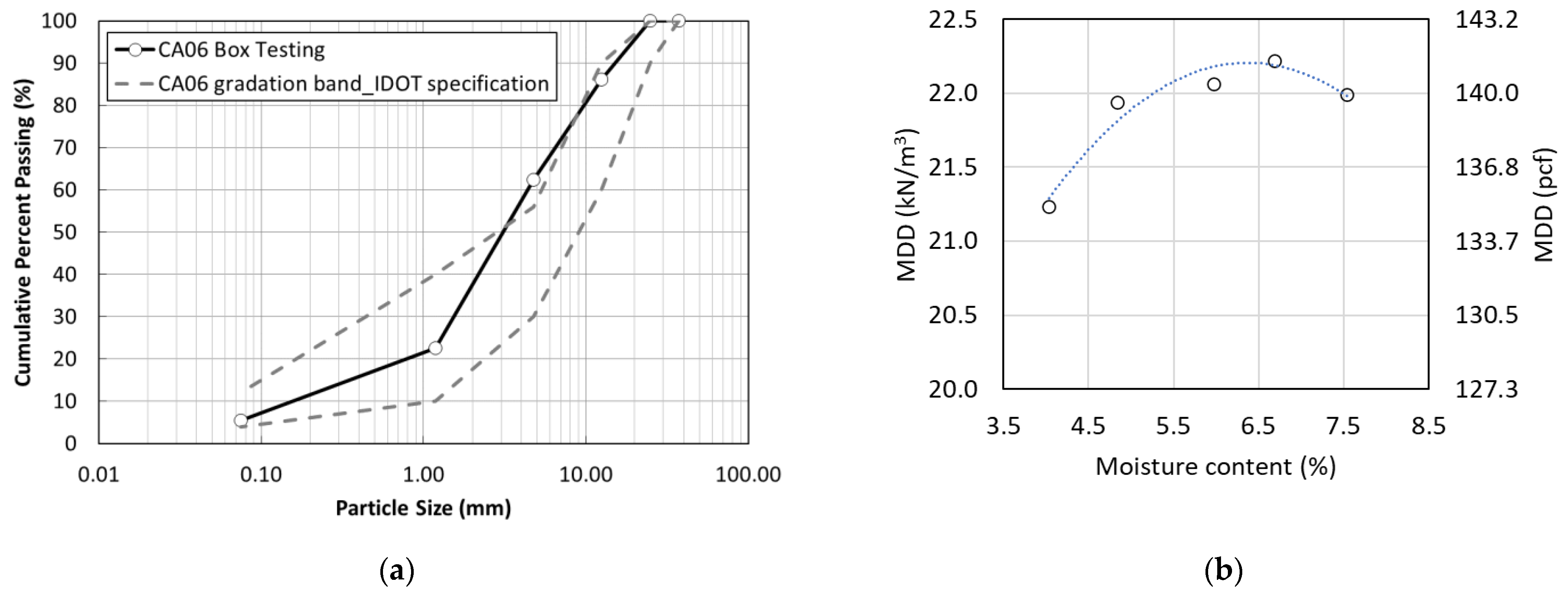
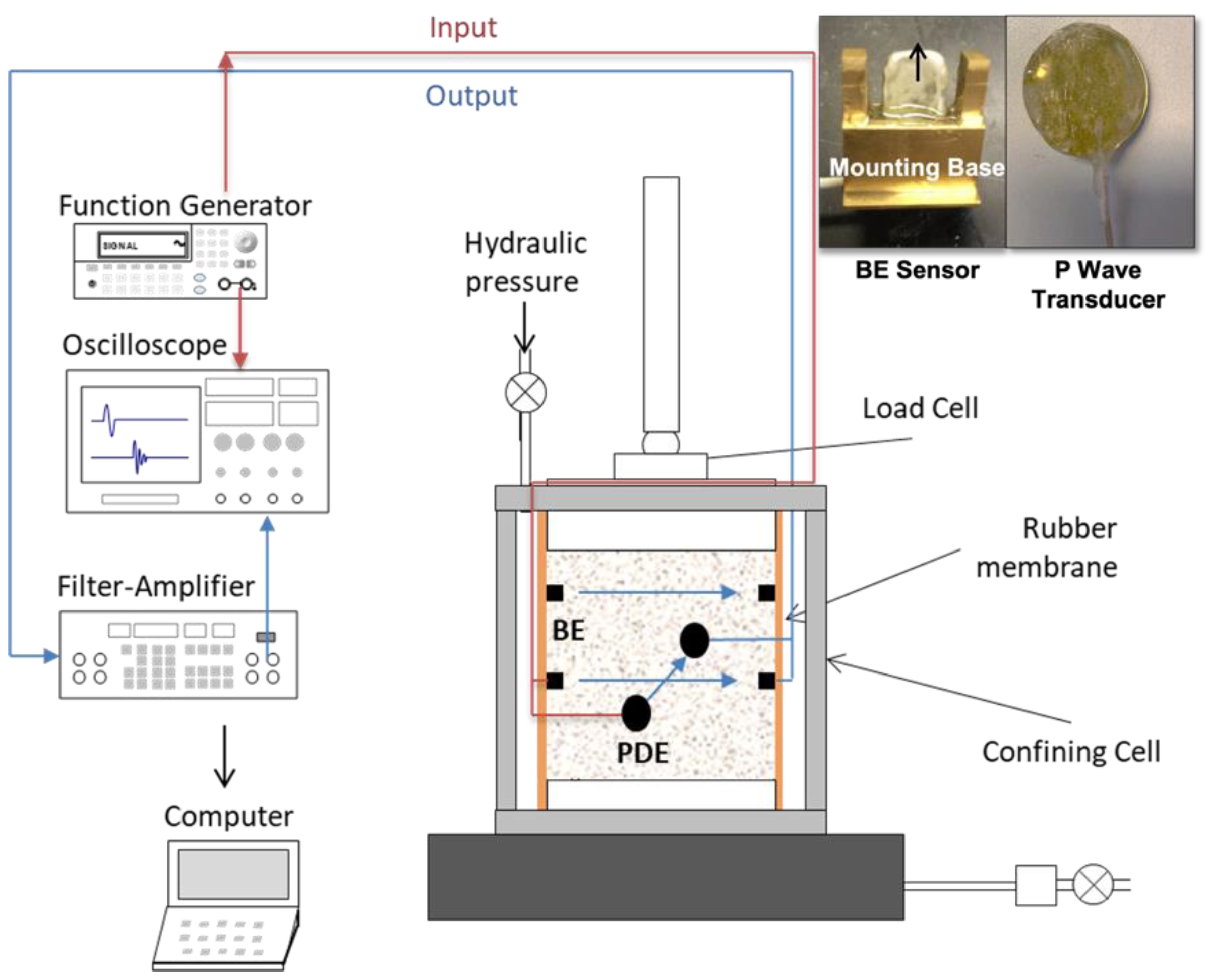
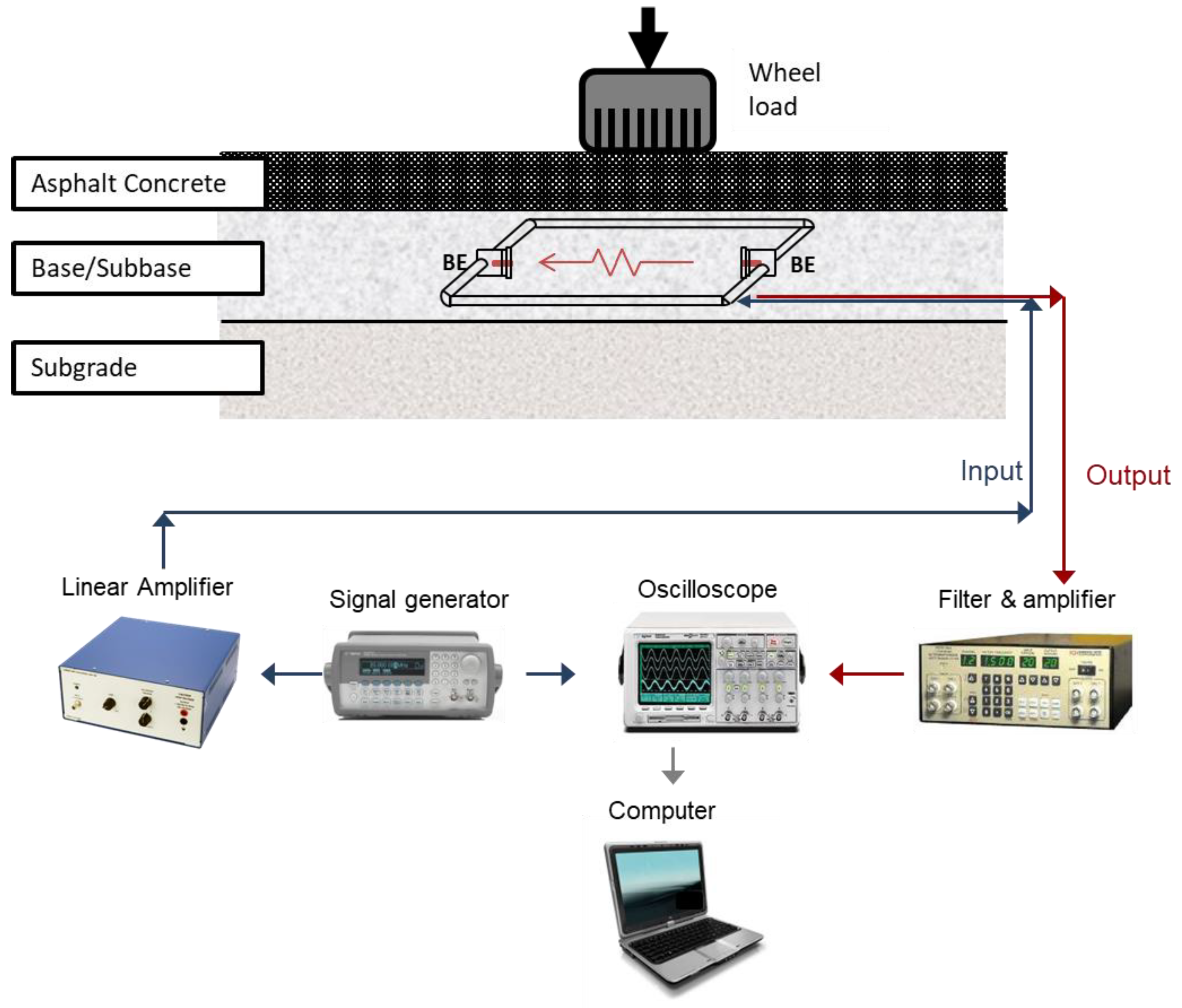
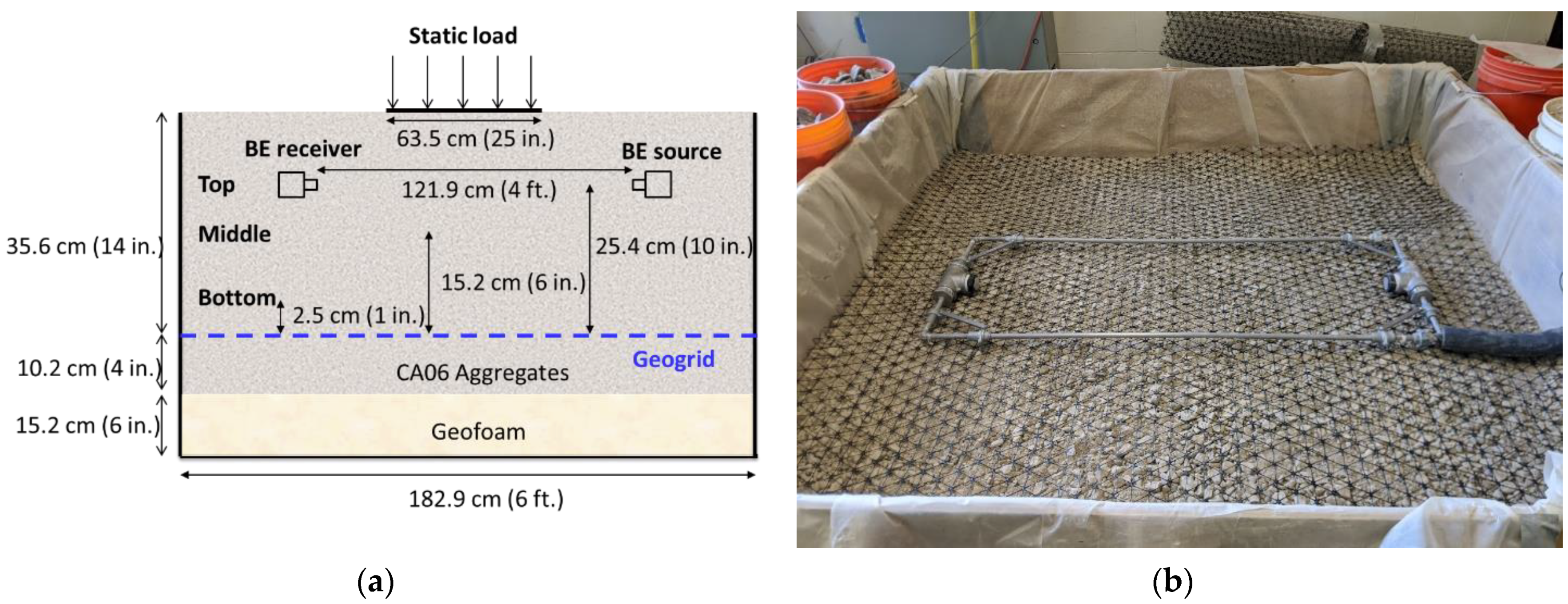
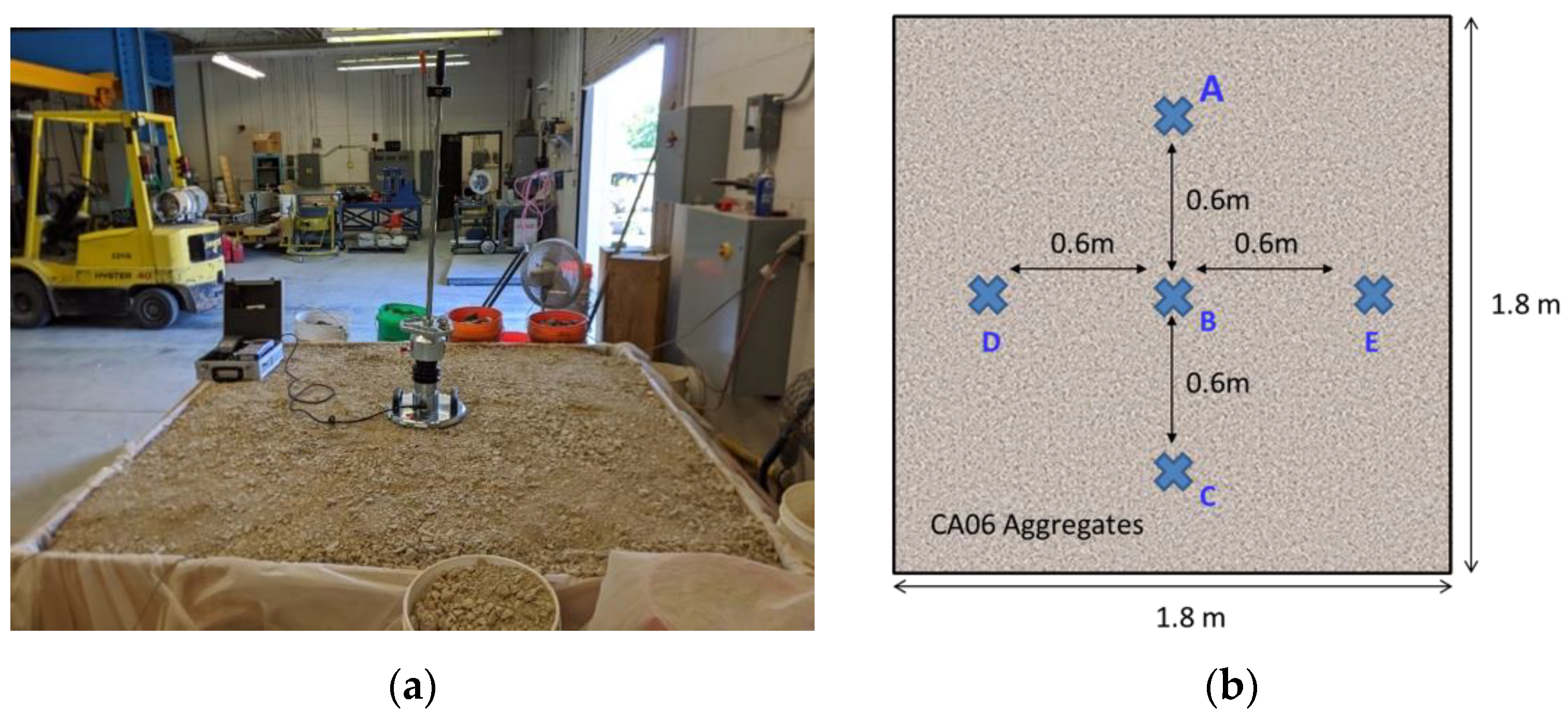
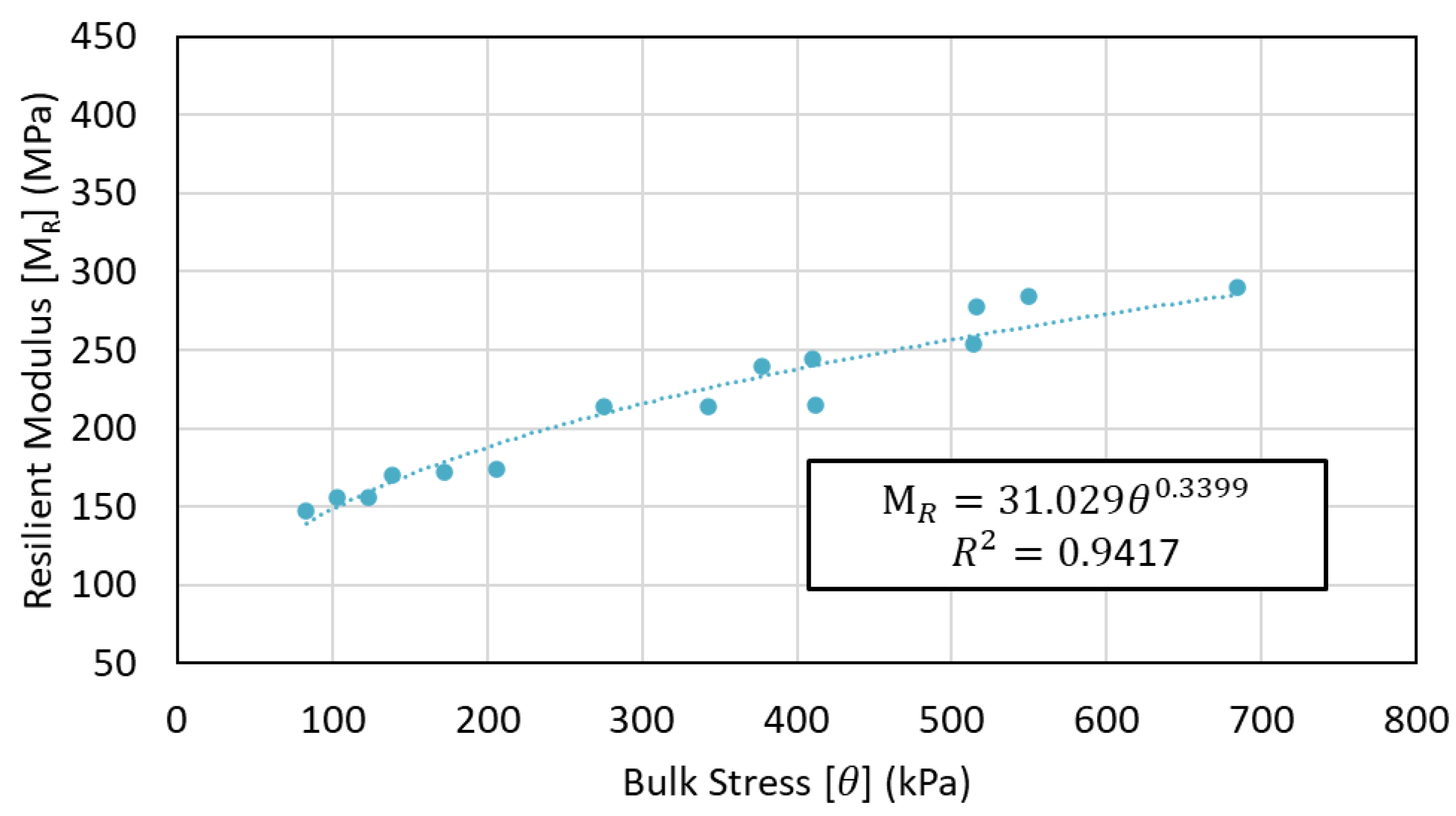
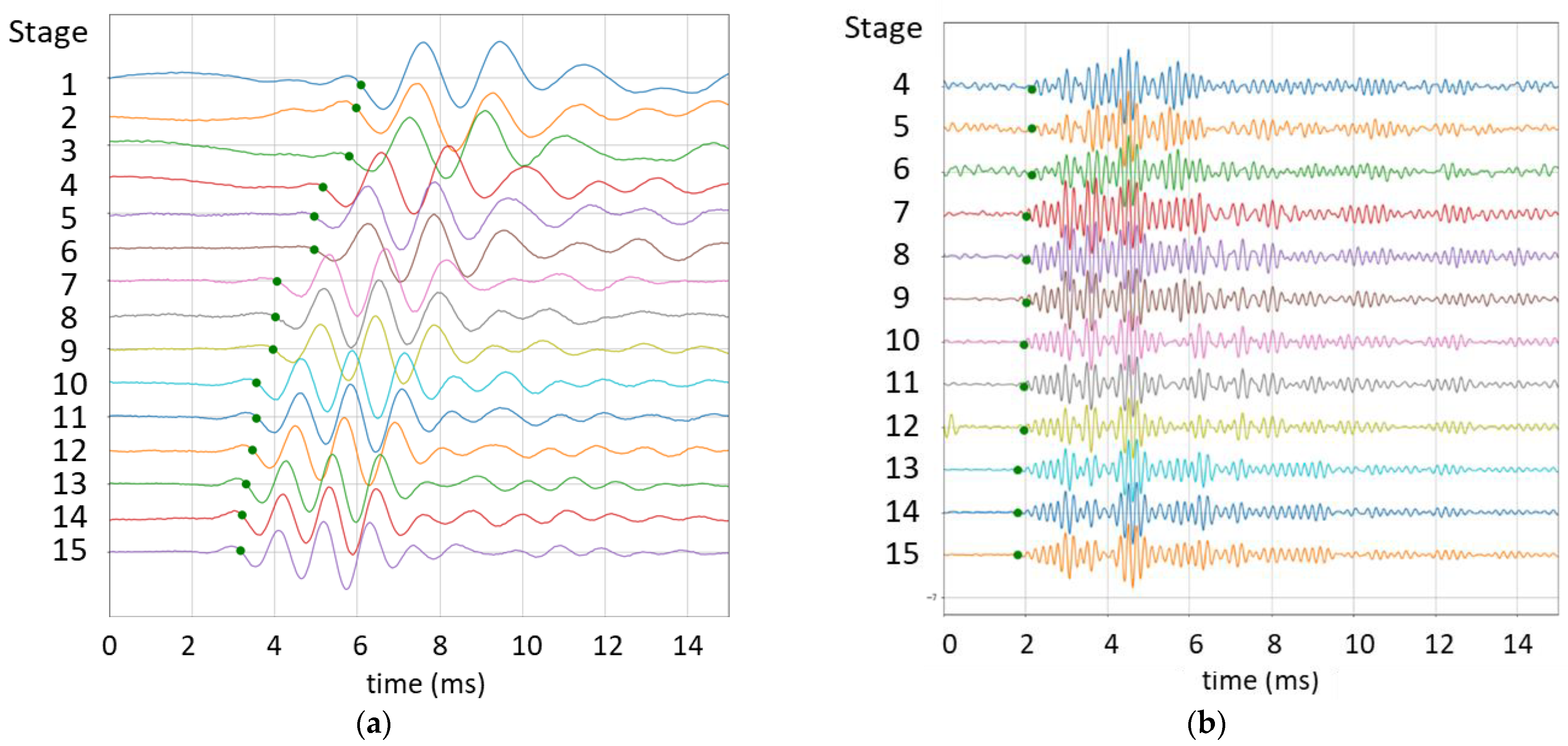

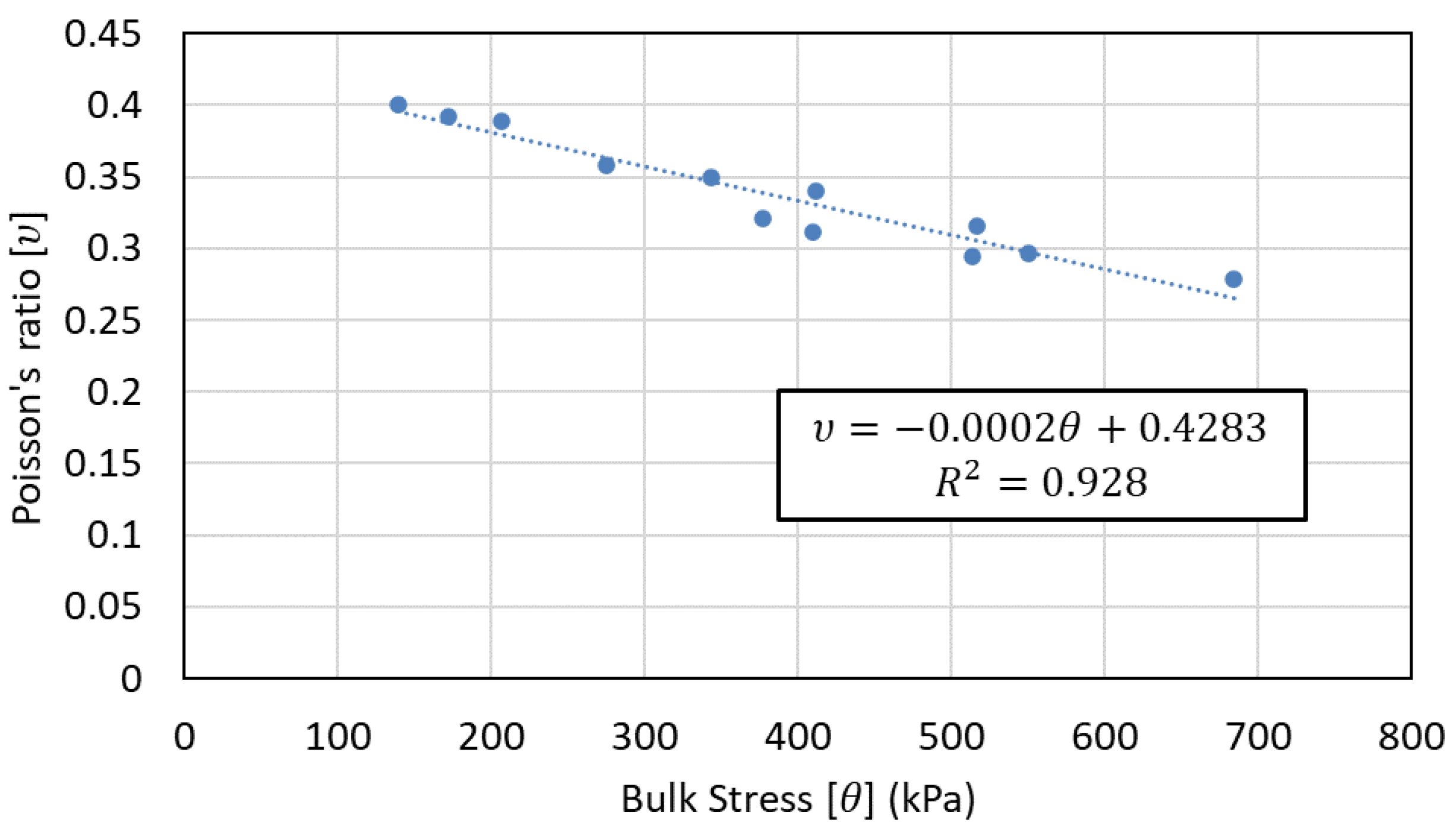
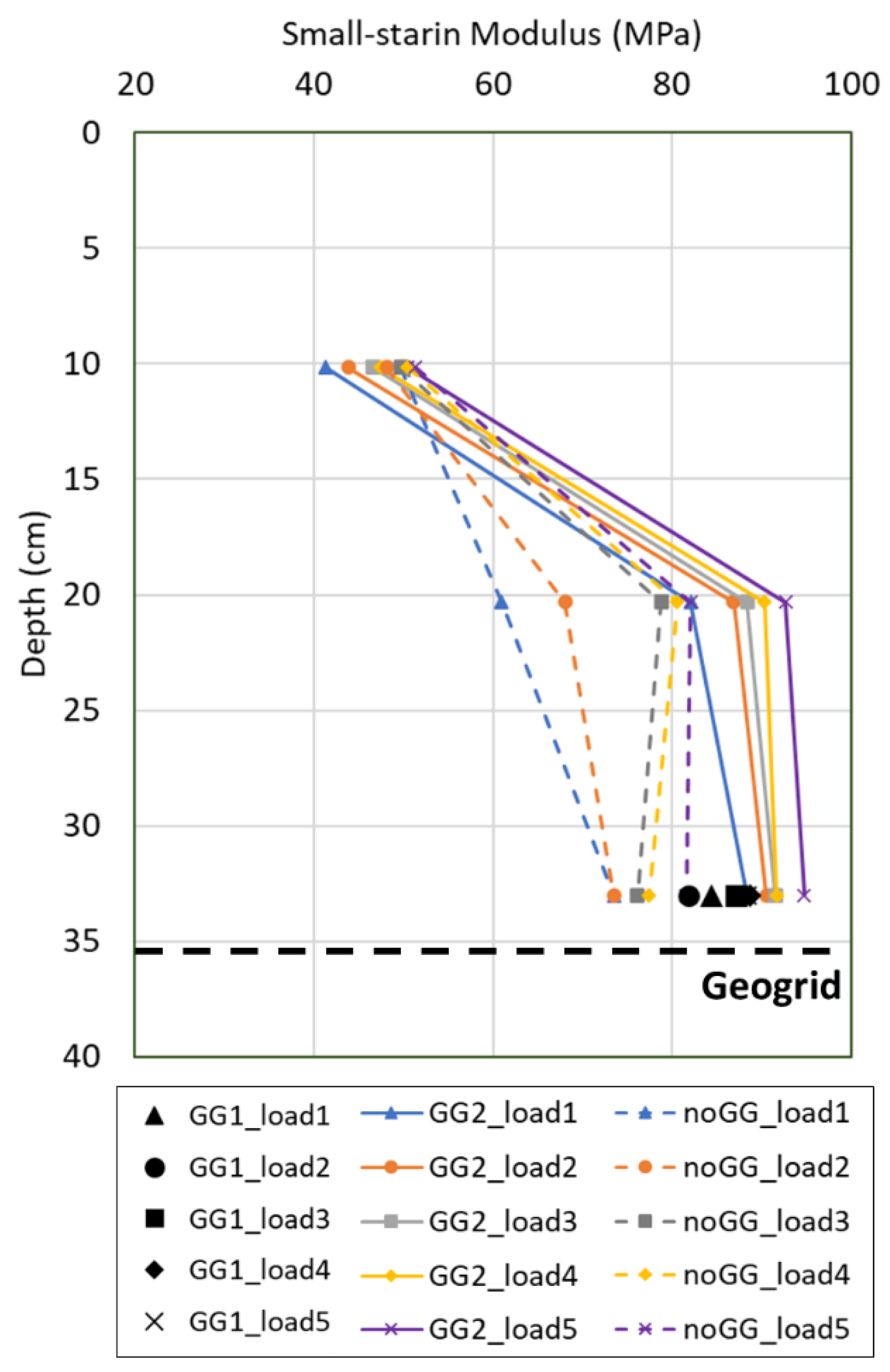
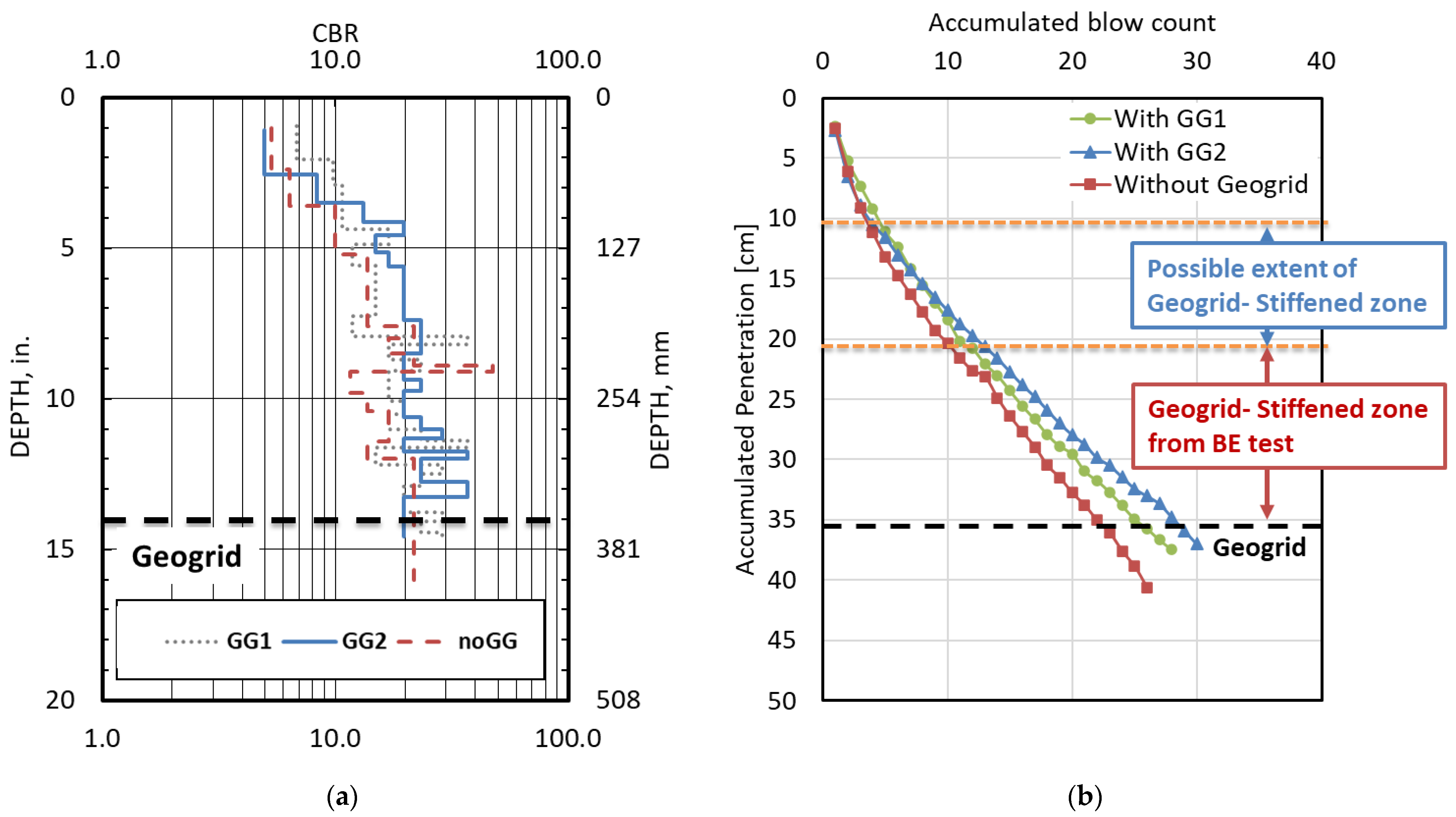
| NMAS | D50 | Cu | Cc | G/S |
|---|---|---|---|---|
| 12.5 mm (0.5 in.) | 3.08 mm (0.12 in.) | 28.36 | 3.46 | 0.66 |
| Index Property | Geogrid #1 (GG1) | Geogrid #2 (GG2) | ||||
|---|---|---|---|---|---|---|
| Long. 1 | Diag. 1 | Trans. 1 | Long. 1 | Diag. 1 | Trans. 1 | |
| Rib pitch (mm) | 40 | 40 | 33 | 33 | ||
| Mid-rib depth (mm) 2 | 1.3 | 1.2 | 1.6 | 1.2 | ||
| Mid-rib width (mm) 2 | 0.9 | 1.2 | 0.4 | 0.7 | ||
| Diameter of largest inscribed circle (mm) | 23.1 | 19.1 | ||||
| Schematic drawing of the aperture shape and the size of inscribed circle | 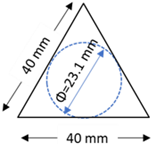 | 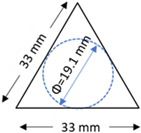 | ||||
| Test No. | Sensor Location | Distance from Geogrid (cm) | Geogrid Placement |
|---|---|---|---|
| 1 | Bottom | 2.5 | GG1 |
| 2 | Bottom | 2.5 | GG2 |
| 3 | Bottom | 2.5 | No Geogrid |
| 4 | Middle | 15.2 | GG2 |
| 5 | Middle | 15.2 | No Geogrid |
| 6 | Top | 25.4 | GG2 |
| 7 | Top | 25.4 | No Geogrid |
| No. | Confining Pressure [kPa] | Deviator Stress [kPa] | Bulk Stress [kPa] | No. of Load Cycles |
|---|---|---|---|---|
| Cond. | 103.4 | 103.4 | 413.6 | 1000 |
| 1 | 20.7 | 20.7 | 82.8 | 100 |
| 2 | 20.7 | 41.4 | 103.5 | 100 |
| 3 | 20.7 | 62.1 | 124.2 | 100 |
| 4 | 34.5 | 34.5 | 138 | 100 |
| 5 | 34.5 | 68.9 | 172.4 | 100 |
| 6 | 34.5 | 103.4 | 206.9 | 100 |
| 7 | 68.9 | 68.9 | 275.6 | 100 |
| 8 | 68.9 | 137.9 | 344.6 | 100 |
| 9 | 68.9 | 206.8 | 413.5 | 100 |
| 10 | 103.4 | 68.9 | 379.1 | 100 |
| 11 | 103.4 | 103.4 | 413.6 | 100 |
| 12 | 103.4 | 206.8 | 517 | 100 |
| 13 | 137.9 | 103.4 | 517.1 | 100 |
| 14 | 137.9 | 137.9 | 551.6 | 100 |
| 15 | 137.9 | 275.8 | 689.5 | 100 |
| Load No. | Static Load, kN (lb.) | Static Vertical Stress, kPa (psi) |
|---|---|---|
| 1 | 0.00 (0) | 0.00 (0.00) |
| 2 | 0.67 (151) | 1.97 (0.29) |
| 3 | 1.32 (297) | 3.89 (0.56) |
| 4 | 1.94 (436) | 5.72 (0.83) |
| 5 | 2.85 (641) | 8.41 (1.22) |
| Test No. | Surface Modulus (MPa) | Geogrid Placement |
|---|---|---|
| 2 | 26.2 | GG2-stabilized |
| 3 | 18.2 | No geogrid |
| 4 | 23.4 | GG2-stabilized |
| 5 | 27.3 | No geogrid |
| 6 | 23.3 | GG2-stabilized |
| 7 | 27.1 | No geogrid |
Disclaimer/Publisher’s Note: The statements, opinions and data contained in all publications are solely those of the individual author(s) and contributor(s) and not of MDPI and/or the editor(s). MDPI and/or the editor(s) disclaim responsibility for any injury to people or property resulting from any ideas, methods, instructions or products referred to in the content. |
© 2023 by the authors. Licensee MDPI, Basel, Switzerland. This article is an open access article distributed under the terms and conditions of the Creative Commons Attribution (CC BY) license (https://creativecommons.org/licenses/by/4.0/).
Share and Cite
Kang, M.; Wang, H.; Qamhia, I.I.A.; Tutumluer, E.; Tingle, J.S. Local Stiffness Assessment of Geogrid-Stabilized Unbound Aggregates in a Large-Scale Testbed. Appl. Sci. 2024, 14, 352. https://doi.org/10.3390/app14010352
Kang M, Wang H, Qamhia IIA, Tutumluer E, Tingle JS. Local Stiffness Assessment of Geogrid-Stabilized Unbound Aggregates in a Large-Scale Testbed. Applied Sciences. 2024; 14(1):352. https://doi.org/10.3390/app14010352
Chicago/Turabian StyleKang, Mingu, Han Wang, Issam I. A. Qamhia, Erol Tutumluer, and Jeb S. Tingle. 2024. "Local Stiffness Assessment of Geogrid-Stabilized Unbound Aggregates in a Large-Scale Testbed" Applied Sciences 14, no. 1: 352. https://doi.org/10.3390/app14010352
APA StyleKang, M., Wang, H., Qamhia, I. I. A., Tutumluer, E., & Tingle, J. S. (2024). Local Stiffness Assessment of Geogrid-Stabilized Unbound Aggregates in a Large-Scale Testbed. Applied Sciences, 14(1), 352. https://doi.org/10.3390/app14010352







